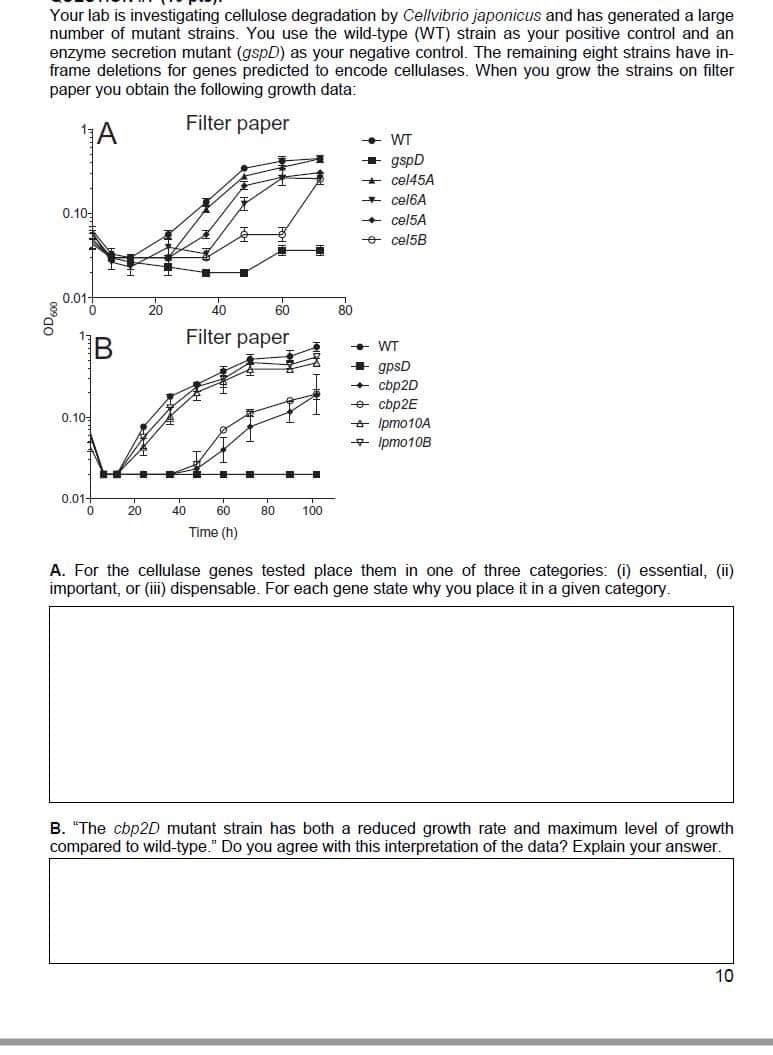Your lab is investigating cellulose degradation by Cellvibrio japonicus and has generated a large number of mutant strains. You use the wild-type (WT) strain as your positive control and an enzyme secretion mutant (gspD) as your negative control. The remaining eight strains have in- frame deletions for genes predicted to encode cellulases. When you grow the strains on filter paper you obtain the following growth data: Filter paper • WT + gspD cel45A cel6A 0.10- + cel5A + cel5B 0.01- 20 80 Filter paper + WT + gpsD + cbp2D e cbp2E + Ipmo10A * Ipmo10B 0.10- 0.01- 20 40 60 80 100 Time (h) A. For the cellulase genes tested place them in one of three categories: (i) essential, (ii) important, or (iii dispensable. For each gene state why you place it in a given category. B. "The cbp2D mutant strain has both a reduced growth rate and maximum level of growth compared to wild-type." Do you agree with this interpretation of the data? Explain your answer. 10
Your lab is investigating cellulose degradation by Cellvibrio japonicus and has generated a large number of mutant strains. You use the wild-type (WT) strain as your positive control and an enzyme secretion mutant (gspD) as your negative control. The remaining eight strains have in- frame deletions for genes predicted to encode cellulases. When you grow the strains on filter paper you obtain the following growth data: Filter paper • WT + gspD cel45A cel6A 0.10- + cel5A + cel5B 0.01- 20 80 Filter paper + WT + gpsD + cbp2D e cbp2E + Ipmo10A * Ipmo10B 0.10- 0.01- 20 40 60 80 100 Time (h) A. For the cellulase genes tested place them in one of three categories: (i) essential, (ii) important, or (iii dispensable. For each gene state why you place it in a given category. B. "The cbp2D mutant strain has both a reduced growth rate and maximum level of growth compared to wild-type." Do you agree with this interpretation of the data? Explain your answer. 10
Biology: The Dynamic Science (MindTap Course List)
4th Edition
ISBN:9781305389892
Author:Peter J. Russell, Paul E. Hertz, Beverly McMillan
Publisher:Peter J. Russell, Paul E. Hertz, Beverly McMillan
Chapter15: From Dna To Protein
Section15.1: The Connection Between Dna, Rna, And Protein
Problem 1SB
Related questions
Question
I need to check my answers, with the help of ur answers

Transcribed Image Text:Your lab is investigating cellulose degradation by Cellvibrio japonicus and has generated a large
number of mutant strains. You use the wild-type (WT) strain as your positive control and an
enzyme secretion mutant (gspD) as your negative control. The remaining eight strains have in-
frame deletions for genes predicted to encode cellulases. When you grow the strains on filter
paper you obtain the following growth data:
Filter paper
+ WT
+ gspD
cel45A
+ cel6A
+ cel5A
e cel5B
0.10-
0.01
20
40
60
80
Filter paper
B
+ WT
+ gpsD
+ cbp2D
e cbp2E
+ Ipmo10A
+ Ipmo10B
0.10-
0.01-
20
40
60
80
100
Time (h)
A. For the cellulase genes tested place them in one of three categories: (i) essential, (ii)
important, or (ii) dispensable. For each gene state why you place it in a given category.
B. "The cbp2D mutant strain has both a reduced growth rate and maximum level of growth
compared to wild-type." Do you agree with this interpretation of the data? Explain your answer.
10
Expert Solution
This question has been solved!
Explore an expertly crafted, step-by-step solution for a thorough understanding of key concepts.
Step by step
Solved in 2 steps

Knowledge Booster
Learn more about
Need a deep-dive on the concept behind this application? Look no further. Learn more about this topic, biology and related others by exploring similar questions and additional content below.Recommended textbooks for you

Biology: The Dynamic Science (MindTap Course List)
Biology
ISBN:
9781305389892
Author:
Peter J. Russell, Paul E. Hertz, Beverly McMillan
Publisher:
Cengage Learning

Biology: The Dynamic Science (MindTap Course List)
Biology
ISBN:
9781305389892
Author:
Peter J. Russell, Paul E. Hertz, Beverly McMillan
Publisher:
Cengage Learning